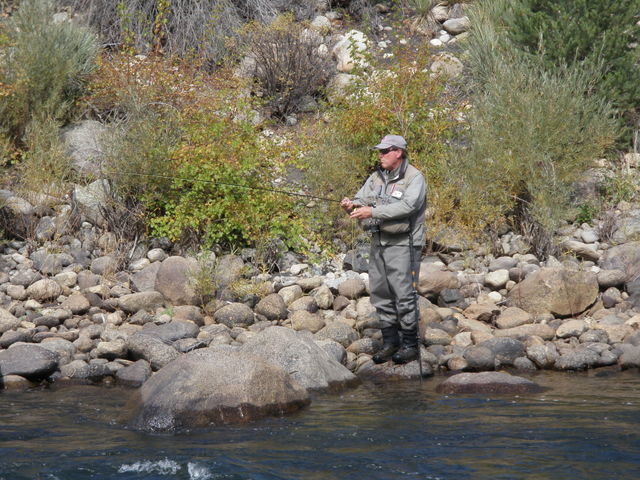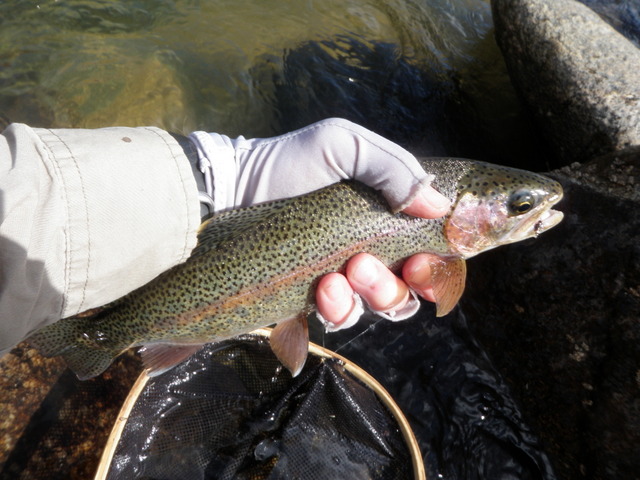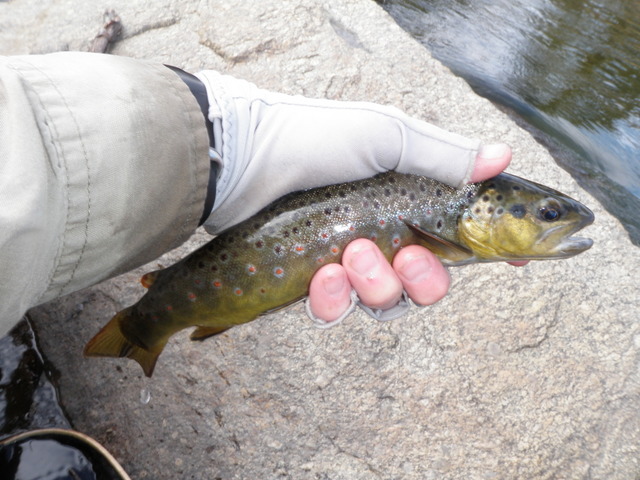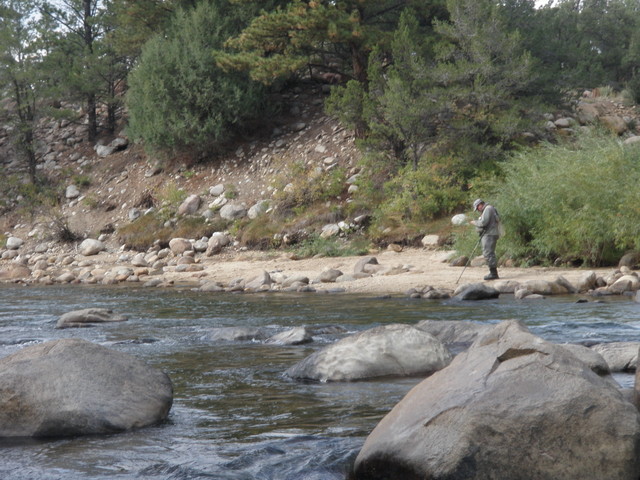Time: 11:00AM – 4:30PM
Location: Tunnels area north of Buena Vista
Fish Landed: 17
Arkansas River 09/21/2014 Photo Album
Sunday September 21 was probably my last opportunity to fish in September, so I made plans to visit the Arkansas River. The weather report concerned me with a high probability of rain, but overcast skies and light rain generally portend blue winged olive hatches and good fishing, so I decided to follow through with my plan. I mentioned my planned fishing trip to Todd Grubin on Friday, and he agreed to join me. I described the location of the Fremont- Chafee border to Todd, and we agreed to meet there at around 10AM.
I departed Stapleton by 6:40, and the sky was quite overcast and foggy for much of the trip. Unfortunately when I turned left off of 285 on to CO 291, the drizzle changed to rain, and as I crossed the river at the bridge just before Salida, I was disappointed to see a red mud color. Normally I would have turned around at this point, but Todd was meeting me at the county line, so I proceeded downstream. I executed a U-turn and pulled next to Todd along route 50, and we agreed that fishing in the Arkansas River below Salida was not going to happen.
We agreed to continue on route 50 to the ArkAnglers fly shop to inquire about alternative fishing options. It continued to rain steadily as we pulled up to the shop. The salesperson inside told us that the mud was originating in Browns Canyon, and our safest contingency plan would be to fish in an area north of Buena Vista that is referred to as the tunnels. We left with the intention of following ArkAngler’s recommendation, however, as I crossed the Arkansas River at the Stone Bridge access, the river did not look off colored. This surprise caused me to turn left and drive to he Smythe Lease.
The dirt road converted into mud, and Todd and I carefully negotiated the slippery surface to the entrance to the lease. The lease sign was gone, and the gate was open, and excavation equipment was parked near the entrance. Since there was no sign indicating private or no trespassing, we agreed to drive to the parking area. The steady rain changed the recently graded road to mud, and I grew quite concerned that one of us would get stuck and require a tow. Just before the parking area we needed to cross a newly carved lane that ran perpendicular to the road we were on, and there was a drainage ditch between us and the parking lot. I gunned the engine and slid across with a bit of fishtailing and breathed a sigh of relief when I made it.
We prepared to fish while the rain continued to descend in steady sheets, and then we walked down the path to the river. We discovered a very new stair step structure over the fence, so we concluded that the area was still open to the public. Unfortunately when we reached the river, we discovered the water was a deep brown color, rather than the red hue we had seen below Salida When I glanced down at the river while crossing the bridge, I failed to notice the murky color because I was expecting to see red mud Todd tied on a San Juan worm, and I knotted on a black leech, and we fished for ten minutes with no action.
Todd and I concluded that it was futile and decided to move on to the tunnels where the water was at least clear. We both agreed it was foolish to continue flailing in dirty water when clear water beckoned farther upstream Crossing the ditch on the gradual uphill was even scarier than on the way in, and I was thankful for the AWD which activated for 20 seconds as I spun through the treacherous mud. As we drove north on route 285 the rain slowed, but the sky remained overcast with dense gray clouds everywhere.
Finally at 10:45 we reached the tunnels area, and as one would expect, there were a series of short tunnels cut in the rocky hills that ran up to the edge of the river. We parked beyond the last opening and descended a steep path that crossed the railroad tracks before reaching the river. As the sky remained quite gray, and the sun was nowhere in sight, I chose not to apply sun screen. Finally after leaving the house at 6:40AM, I was ready to begin fishing at 11:00AM.
Both Todd and I elected to begin fishing with strike indicator nymph rigs since that is what remained on our lines from the brief visit to the Smythe Lease. The water in the tunnels area was crystal clear and deceptively deep as a result of the narrow streambed, and this thwarted my efforts to cross to the opposite bank. Consequently Todd and I alternated positions on the eastern side over the first hour. I beganwith a 20 incher and a beadhead hares ear, but these flies yielded no results. After a bit I exchanged the hares ear for a RS2, but this likewise failed to produce, so I abandoned the nymphing approach and switched to a dry/dropper with a tan Charlie Boy hopper, beadhead hares ear, and the RS2. As these flies swept by the front of a large exposed boulder, I felt some weight and set the hook, and a fish shot diagonally upstream. I gave the fish line at a rapid rate, but my efforts were to no avail as the streaking missile snapped off the hares ear and RS2.
I replaced the lost flies with matching imitations from my fleece pouch and resumed fishing and quickly landed a small brown trout to register the first landed fish of the day. I now moved upstream along the bank and popped casts to the pockets and riffles of moderate depth where the dry/dropper approach is typically effective. I continued to alternate stretches with Todd, and at 12:30 we arrived at a long deep pool. I was about to skip around the pool since this type of water is not very conducive to the dry/dropper method, but we began to see rises near the tail. It was also around this time that the sun broke through the clouds, and Todd loaned me his sunscreen. Brief periods of sunshine began to appear among the predominant dense cloud cover.
While Todd and I stood at the tail of the pool observing the frequent rises, I spotted a pair of blue winged olives, and with this information, Todd jumped in and began casting to rising fish. I meanwhile moved to the midsection still intending to skip by the pool and fish the soft hackle emerger in the faster water at the head of the pool and above. As I moved along, however, I observed an increasing number of emerging mayflies and rising fish. I couldn’t resist the challenge, so I snipped off the dry/dropper flies and tied on a size 20 CDC olive.
A strong breeze was blowing up the river, and this played havoc with my attempted downstream and across presentations, as the wind repeatedly straightened my leader and removed all the slack. In addition I experienced difficulty picking up where my fly landed because of the repositioning caused by the breeze. I persisted in this frustrating manner of fishing for 30 minutes with a refusal or two as my only reward, while Todd meanwhile landed a pair of fish on his size 18 parachute Adams with an olive body. In addition Todd also experienced numerous refusals, or “swats”, as he refers to them.
During a pause in the hatch I decided to eat my lunch on a large high rock above the pool, but before doing so I planned to take a photo of Todd. At this point I discovered that I left the camera in the car, so I walked back to the Santa Fe and retrieved the camera, disposed of some trash, and removed my raincoat and pulled on sungloves.
When I returned to the pool, the hatch resumed, but I resolved to save myself frustration and moved to the top of the pool and returned to the Charlie Boy, hares ear, and soft hackle emerger. I managed to land a few more small brown trout on the hares ear, but the soft hackle emerger was not adding value and the hatch ended, so I substituted a beadhead pheasant tail.
I finally reached a wide shallow point where I was certain I could safely cross, and I successfully did so. Now Todd and I could work up the river in parallel. The Charlie Boy began to inspire rejections from curious fish so I once again made a change to my array of offerings and tied on a Chernobyl ant in place of the hopper. I also suspected that my leader was too short for the deceptively deep pockets and plunge pools in this rocky area, so I extended my tippet an additional 18 inches.
With these changes I finally fell into a nice rhythm on the west bank, and my catch frequency surged, although the fish were predominantly 9-11 inch brown trout. I am convinced that the deeper drift created by extending my leader was a major contributing factor to the higher catch rate. One of the fish succumbed to the pheasant tail, but more snatched the hares ear, so I once again reconfigured by moving the hares ear to the point position and then tried the ultra zug bug as the middle fly.
This combination of flies really clicked, and I rapidly moved my fish count to 17. Interestingly the ultra zug bug began to outperform the hares ear as the afternoon progressed. The most productive areas on the river were wide riffles of moderate depth and the cushion in front of large boulders when accompanied by a lift or sweep. Also prime areas were narrow deep slots between large rocks and faster currents.
Sunday was not the day I expected in my favorite water east of Salida, but the water was clear and the weather evolved into a cool pleasant afternoon, and I managed to land 17 small trout. My best fish was a 12 inch rainbow, and I added three eleven inch browns. Todd did not sample the best that the Arkansas River has to offer, but hopefully I can convince him to return another time under more favorable conditions.




